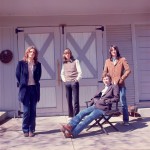INTRO
Digging into the record shelves of the past and filing through the film drawers of yesterday, the new column from the A&E; editors, Throwback Thursday, brings you some of the greatest and most overlooked A&E; talent of the past. So dust off your record players and VHS tapes, and find something of the past that is currently revitalizing the present.
BIG STAR
There’s something tremendously moving about the first time you listen to Big Star. Maybe it’s frontman Alex Chilton’s bright, twangy guitar over the intricate drums of Jody Stephens. Or maybe it’s the mix of Chris Bell’s atmospheric vocals with Chilton’s calming voice. But probably it’s the realization that an alternative rock sound that belongs in the ’90s was somehow passed over in 1972.
It’s the story of Big Star, a Memphis rock ‘n’ roll band that created three of the most critically acclaimed albums in American music, but was never able to obtain equivalent popular success. The latest revival of Big Star’s music comes courtesy of Drew DeNicola and Olivia Mori’s “Big Star: Nothing Can Hurt Me,” a documentary of the band that is being featured at select theaters across the county. The documentary’s ability to tell the hidden story of a band that paved the way for alternative rock without reaching an audience, inspires a generation revived on painfully emotive rock.
The band, consisting of Chilton and Bell on guitar and vocals, Andy Hummel on bass and Stephens on drums, was founded in 1971, when Chilton, previously a member of the Box Tops, a hit 1960s soul band, was asked to join Big Star. Bell and Chilton struck a Lennon and McCartney feel, and the band released its debut album, “#1 Record,” in 1972.
Not every band can call itself Big Star, and even fewer could name their first album “#1 Record.” But Big Star presented something not yet heard in music. Stemming from the band’s Memphis roots of Elvis-inspired blues rock, and its devotion to the Beatles, Big Star gave the 1970s a new taste of what music could sound like. “#1 Record” provides an answer with its ability to further sound on the guitar, with vocals that cry out for attention and drums that capture the pace of the songs.
Chilton’s and Bell’s guitars on the lead track, “Feel,” were undeniably something new to rock music at the time, with a simple lead guitar hiding under the crunchy rhythm section present in much of the alternative rock that would succeed it. Bell’s scratchy, high cry of a voice over Chilton’s smooth, honest vocals make for one of the decade’s greatest melancholic albums in rock music.
Up and down the record are some of the most intricately devised songs, perhaps too innovative for popular audiences, such as “The Ballad of El Goodo,” “Thirteen,” “When My Baby’s Beside Me” and “Watch the Sunrise.” Despite the band’s poor album sales and lack of touring, “#1 Record” was received just as the title suggests by numerous music journalists, from Lester Bangs of Creem to Cameron Crowe of Rolling Stone.
Sales for the album, however, failed to top 10,000 copies, and conflicts within the band led to Bell’s departure. While Chilton and the rest of the members never were able to achieve the same musical genius, the band put out two more albums, “Radio City” in 1974 and “Third/Sister Lovers” in 1978 to continued critical acclaim. The band seemed to be finished and dispersed as quick as it came, with Chilton moving on to his grand solo career, blazing a trail of alternative rock for the next 20 years.
Within the next decade, however, it was clear that the catalogue left behind by Big Star was creating rippling waves of new music throughout rock. Bands like the Replacements, a Minneapolispunk rock band that began the first wave of alternative rock, expressed much gratitude for Big Star, even naming one of its songs, “Alex Chilton.” When bands like The Posies and R.E.M. began citing Big Star as an influence, the records were unearthed for a new generation. A generation that found music written two decades ago that connected to them and bridged the gap between the rock ‘n’ roll of the ’60s and their day.
Even with the passing of Chilton and Bell, Big Star continues to find a niche in modern music. The mature and elegantly destructive sounds of Big Star can give to this generation the same honest, painful expression that alternative rock fed on decades before. And with a rejuvenation of the band’s ancestral sound of alternative rock, its music can only spawn a hundred more Elliott Smiths and Michael Stipes to explore more of what alternative rock is capable of.
Big Star Playlist:
